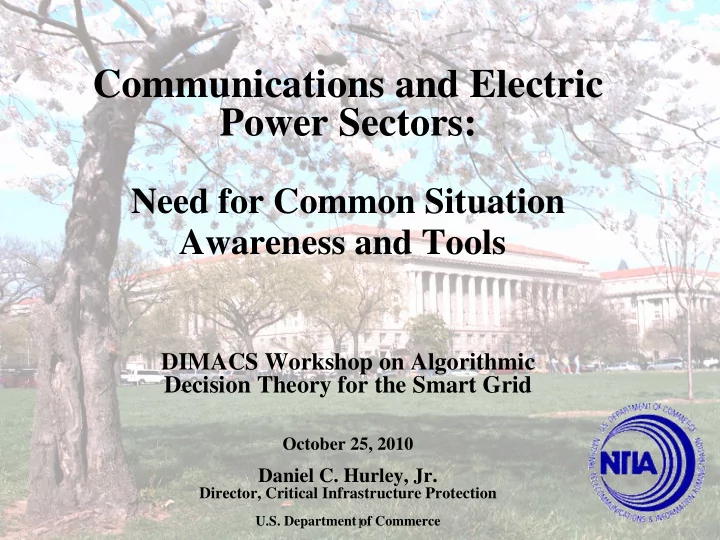

Communications and Electric Power Sectors: Need for Common Situation Awareness and Tools DIMACS Workshop on Algorithmic Decision Theory for the Smart Grid – October 25, 2010 Daniel C. Hurley, Jr. Director, Critical Infrastructure Protection U.S. Department of Commerce 1
Background • Communications Dependency on Electric Power Working Group (CDEP WG) established at the May 23, 2007, Committee of Principals (24 agencies) (COP) Meeting. • COP tasked the CDEP WG to examine issues raised by the President’s National Security Telecommunications Advisory Committee’s (NSTAC) Report to the President on Telecommunications and Electric Power Interdependencies: The Implications of Long-Term Outages (TEPI Report). • CDEP WG issued report in February 2009. • Efforts underway to act on recommendations. 2
Participants and Input • Participation in the CDEP WG included representatives from: – NCS COP members, including: NTIA, DOE, FEMA, DHS, FRB, FCC, USDA – North American Electric Reliability Corporation – Federal Energy Regulatory Commission – Electric Power Research Institute – Edison Electric Institute – Idaho National Laboratories – Reliability First – Telcordia – Nortel – Virginia Polytechnic Institute and State University – Johns Hopkins University – Ohio State University 3
CDEP WG Report & Appendices • The CDEP WG Final Report covers the following areas: – Chapter 1: Definitions of an LTO and a short-term outage – Chapter 2: Current Governance Procedures – Chapter 3: Science and Technology – Chapter 4: Financial Analyses – Chapter 5: Cross-Sector Situational Analysis Tools – Chapter 6: LTO Workshop – Chapter 7: Development of Continuum of Exercises on LTO Situations – Chapter 8: Assured Service Agreements between Sectors – Chapter 9: Risk Management Assessments – Chapter 10: Development of a General LTO Prioritization Matrix • The Appendices to the CDEP WG Report include additional information pertaining to these chapters 4
Selected Findings • CDEP WG sponsored a Local Providers Workshop to discuss the development of realistic communications and situational awareness strategies for use during an LTO of more than two weeks in the Washington, D.C., region. • Findings Included: – Electric utilities are directed by state government officials on the priority for restoration of services, while communications companies are driven by national TSP agreements that are in place with their customers. – Representatives identified a logical location on the priority list for restoration of critical communications facilities. – The two sectors typically join forces to restore service at the state EOC level . However, much of the coordination is performed on an ad hoc basis at the local level. – Access control and fuel availability issues need to be resolved before an LTO occurs. 5
CDEP WG Recommendations The CDEP WG developed a total of 39 recommendations, including: • COP – Encourage the communications and electric power Sector Coordinating Councils, Government Coordinating Councils, and Information Sharing and Analysis Centers to work together to present LTO plans and mitigation strategies to national councils • NERC – Prepare an outage map standard and encourage all electric power companies to develop uniform outage maps. – Encourage the IEEE to develop a standard set of meta-data for power outage maps that includes relevant Global Information System data 6
7
Awareness and Analysis Tools Tools examined include: • North American SynchroPhasor Initiative (NASPI) • Frequency Monitoring Network (FNET) • Situation Awareness Tool (SAT) • Real-Time Dynamics Monitoring System (RTDMS) • Infrastructure Mapping Tool (IMT) • Spatial Infrastructure Mapping and Analysis Tool (SIMAT) • Visualizing Energy Resources Dynamically on Earth (VERDE) 8
Tools, cont’d. • North American SynchroPhasor Initiative (NASPI) – Developed by NASPI; www.naspi.org – Uses synchrophasors, distributed across power system to deliver system metrics • Frequency Monitoring Network (FNET) – Developed by Virginia Tech; http://www.powerit.vt.edu/FNET.htm – Performs GPS synchronized frequency data measurement and information across North American continent • Situation Awareness Tool (SAT) – Developed by NERC; www.nerc.com – Provides high-level overview of situational health of North American electrical grid for 24-hour period; no history or long-term storage • Real-Time Dynamics Monitoring System (RTDMS) – Developed by National Visualization and Analytics Center – PNWNL – http://www.phasor-rtdms.com/ – Phasor-based application that offer real-time wide-area visibility on voltage magnitude and relative angles, angle differences across transmission flowgates, and system and local frequencies • Infrastructure Mapping Tool (IMT) – Developed by National Communication System (NCS); – Provides infrastructure analyses for incident management, decision support and status tracking, layering near real-time data, e.g., weather, traffic, earthquake, over infrastructure data. 9
Tools, cont’d. • FASTMap: Spatial Infrastructure Mapping and Analysis Tool (SIMAT) – Developed by NISAC – Sandia National Laboratory; http://www.sandia.gov/nisac/FASTMap.html – Supports following sectors: transportation, telecommunications, banking and finance, chemical and hazardous materials, and energy • Visualizing Energy Resources Dynamically on Earth (VERDE) – Developed by Oak Ridge National Laboratory; http://www.ornl.gov/sci/electricdelivery/vis_VERDE.html – Provides real-time status of transmission lines of 230K-kV and above, along with weather overlays – Has predictive capabilities that include impact assessment, interdependencies, and population impacts. – Platform can be used to integrate different elements of visualization tools 10
Features of Certain Tools • NASPI • FNET • RTDMS • FASTMap – Foregoing tools all have the following characteristics: • Mature technology • Easily deployed • Low-cost 11
Other Tools • Foregoing listing and discussion do not address the many websites and proprietary tools maintained by individual power companies depicting: – Areas of power outage – Expected time to repair 12
Next Steps • Commissioning of a Government-funded engineering analysis of telecommunications and electric power infrastructures to determine the interdependencies in LTO situations – Recommended by the TEPI Task Force – Although The CDEP WG was not established to perform such an analysis, it has developed information in its Final Report and Appendices to support the analysis from several sources. • Provide assistance to other groups conducting similar investigations, including: – National Academy of Sciences “Severe Space Weather Events-- Understanding Societal and Economic Impacts Workshop Report” – National Infrastructure Advisory Council – EMP Commission “Report to Assess the Threat to the United States from Electromagnetic Pulse (EMP) Attack” 13
Thank You Questions? » U.S. Department of Commerce www.ntia.doc.gov dhurley@ntia.doc.gov 14
Recommend
More recommend